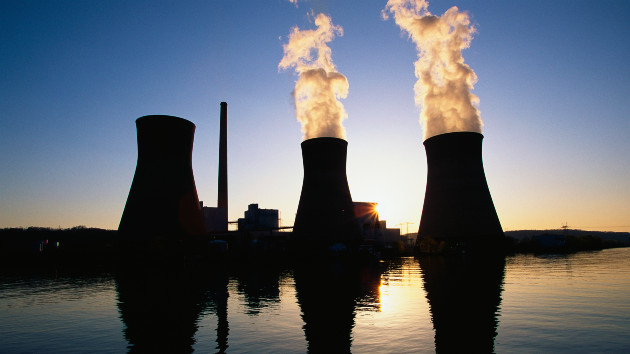EPA limits four types of power plant pollution with sweeping rulemaking

(WASHINGTON) — The Biden administration on Thursday announced a series of new rules to cut pollution emitted from coal and natural gas fired power plants impacting the air, water, land and climate.
“The electricity industry is central to America’s economic growth and independence. These are the folks who keep the lights on and power our country forward,” Environmental Protection Agency Administrator Michael Regan said. “At the same time, the power sector is also a major contributor to the pollution that drives climate change and threatens public health.”
“At EPA it is our responsibility to act within the bounds of our legal authority and assess impacts in a way that is smart, effective, follows the latest science and enables our economy to grow and thrive,” he added.
Power plants account for more than one-quarter of all greenhouse gas emissions in the U.S., according to the EPA, making them one of the most potent sources of climate pollution in the country.
“The age of unbridled climate pollution from power plants is over. These standards cut carbon emissions, at last, from the single largest industrial source,” Manish Bapna, president and chief executive officer of the Natural Resources Defense Council, said. “They fit hand-in-glove with the clean energy incentives in the Inflation Reduction Act to make sure we cut our carbon footprint. They will reduce other dangerous pollutants that foul the air we breathe and threaten our health.”
The agency claims these four new regulations, taken together, will represent a massive reduction in pollution and hundreds of billions of dollars in climate and public health benefits.
Decarbonizing the power sector
The first of the new EPA rules updates a provision of the Clean Air Act to require existing coal-fired power plants and new natural gas plants to control 90% of their carbon pollution through technologies like carbon capture.
Through 2047, an administration regulatory impact analysis found this new standard will avoid 1.38 billion metric tons of carbon pollution — the equivalent of 328 million gas-powered cars’ annual emissions.
Evergreen Action senior policy lead for the power sector Charles Harper told ABC News that the decarbonization measure is a “major game changer for climate action in this country,” saying it will, “get at one of the largest sources of carbon pollution in the economy.”
The Biden administration says the rule will create $370 billion in climate and public health benefits in the next 20 years, including 1,200 avoided premature deaths and 1,900 cases of asthma onset avoided.
“It’s a real win for climate change and folks who live on planet Earth,” Harper added.
Edison Electric Institute, an organization representing U.S. investor-owned electric companies, told ABC News it supports the EPA move, but has concerns.
“While we appreciate and support EPA’s work to develop a clear, continued path for the transition to cleaner resources, we are disappointed that the agency did not address the concerns we raised about carbon capture and storage (CCS),” EEI President and CEO Dan Brouillette said in a statement. “CCS is not yet ready for full-scale, economy-wide deployment, nor is there sufficient time to permit, finance, and build the CCS infrastructure needed for compliance by 2032.”
“We will remain engaged with EPA and with state agencies as they implement these rules,” the organization added. “We also will continue to work constructively with EPA as it develops a new proposal for existing natural gas turbines.”
Tightening mercury and air toxics standards
Another rule updates the Mercury and Air Toxics Standards (MATS) for coal-fired plants.
One provision of the rule tightens the emissions standard for toxic metals by 67%. The other requires a 70% reduction in the mercury emissions standard specifically from lignite coal-fired power plants.
“This new standard will also require the use of continuous emissions monitoring systems to provide real-time accurate data to facility operators and to the public to ensure that plants are meeting these lower limits and that communities are protected year round from pollution exposure,” Regan said.
By 2028, the EPA estimates the new rule will result in 1,000 pounds of mercury emissions reductions in addition to seven tons of other hazardous air pollutant emissions, 770 tons of fine particulate matter pollution and others.
Reducing power plant. waste water pollution
A third rule would reduce waste water pollutants from coal-fired power plants by over 660 million pounds per year, according to the EPA, with the goal of protecting freshwater and drinking water resources for communities around the country.
The agency used its authority under the Clean Water Act for the implementation of this rule, which includes flexible compliance options for coal-fired plants with plans to stop burning coal by 2034. Plants intending to retire coal use will only need to meet current standards, rather than the updated, stricter ones.
President of the Hip Hop Caucus, Rev. Lennox Yearwood, told ABC News that even in divisive times, “people want clean air and clean water.” Yearwood’s organization works on environmental justice efforts, among other priorities.
“We don’t get along right now in our country. We’re not seeing eye to eye on too many things,” Yearwood said. “But one thing that we see eye to eye on is that we all seem to want clean water.”
Yearwood explained that often the burden of pollution falls disproportionately on Black, brown and Indigenous communities, whose communities may be considered “sacrifice zones” by polluters.
The EPA noted the impact of this rule on “communities with environmental justice concerns that are disproportionately impacted” in the release announcing the measures.
Coal ash containment protections
A final rule from the EPA marks the first federal regulation for the management of coal ash, including potential contamination of groundwater.
Burning coal in these power plants creates coal ash, which can contaminate waterways and water systems, in addition to the air, according to the EPA.
The rule, under the Resource Conservation and Recovery Act, requires coal-fired power plants to control and clean coal ash that’s a byproduct of their operation — in addition to areas historically contaminated by coal ash.
“With this rule, we are ensuring that polluters are held accountable for controlling and cleaning up the contamination created by their disposal of coal ash,” Regan said, noting that each of the four new rules contains “transparency requirements” to protect affected communities.
Election-year implications
This slate of rules is accompanied by a separate announcement from the Department of Energy of efforts to build out transmission lines to clean energy sources around the nation.
The new DOE rule creates the Coordinated Interagency Transmission Authorization and Permits (CITAP) program, which aims to make the federal permitting process for transmission projects more efficient — giving them a standardized two-year timeline.
The EPA rules mark the latest in a series of major regulatory announcements by the agency, as it has been working to finalize several outstanding sets of rule proposals.
Environmental organizations told ABC News they have been pressuring the Biden administration to get rules out the door before the Congressional Review Act period begins.
“There’s this one law, called the Congressional Review Act, which might allow Republicans to try to meddle with some of the accomplishments by the Biden Administration and EPA and the Administration is very wary and cognizant of any deadlines posed by the Congressional Review Act,” Harper told ABC News. “The fact that the EPA is finalizing all these rules and month of April means that they’re likely insulated from any potential meddling by congressional Republicans.”
Yearwood said these environmental regulations could have potential to sway the election, but said it’ll be a “mad dash now,” to see which way it goes.
“For my Republican friends, I think that you may have missed the ball with underestimating the importance of clean air and clean water for these communities. That may be their undoing,” he said. “On the other hand, I think, for Democrats, I think that they are in a position where they may have waited too late, actually. This is something that I think should have been moving much stronger on.”
“It just befuddles me that they waited so long to get to the soil on both standpoints. We’ll see. It’ll be a mad dash now because on one hand, I think that if this can be more crystallized for Americans, and they can understand the importance of climate, and particularly pollution, I think that this could actually tilt the scales from one way or the other,” Yearwood said.
Copyright © 2024, ABC Audio. All rights reserved.






